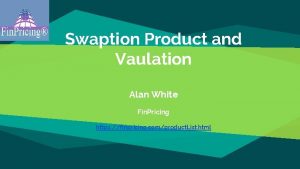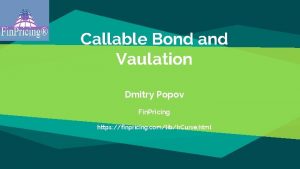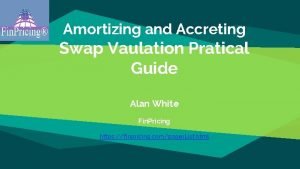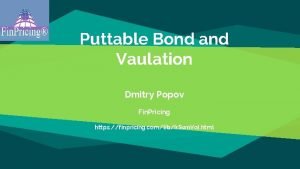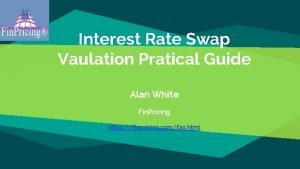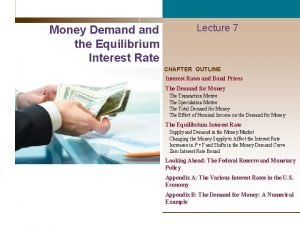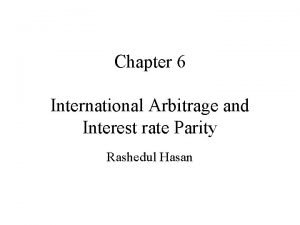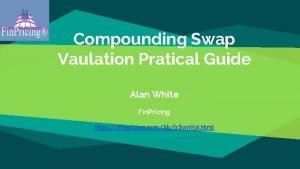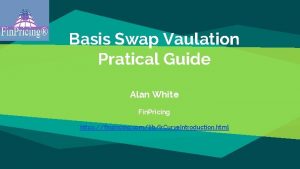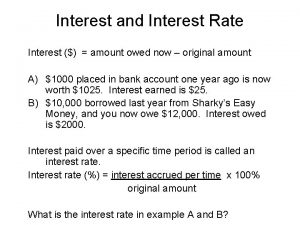Interest Rate Caps and Floors Vaulation Alan White














- Slides: 14

Interest Rate Caps and Floors Vaulation Alan White Fin. Pricing https: //finpricing. com/lib/Ir. Curve. html

Cap Summary ◆ Interest Rate Cap and Floor Introduction ◆ The Use of Caps and Floors ◆ Caplet and floorlet Payoffs ◆ Valuation ◆ Practical Notes ◆ A real world example

Cap Interest Rate Cap and Floor Introduction ◆ An interest rate cap is a financial contract between two parties that provides an interest rate ceiling or cap on the floating rate payments. ◆ An interest rate cap actually consists of a series of European call options (caplets) on interest rates. ◆ The buyer receives payments at the end of each period when the interest rate exceeds the strike. The payment frequency could be monthly, quarterly or semiannually. ◆ An interest rate floor is a financial contract between two parties that provides an interest rate floor on the floating rate payments.

Cap Interest Rate Cap and Floor Introduction (Cont) ◆ An interest rate floor actually consists of a series of European put options (floorlets) on interest rates. ◆ The buyer receives payments at the end of each period when the interest rate falls below the strike. The payment frequency could be monthly, quarterly or semiannually. ◆ The exercise is done automatically that is different from any other types of options. ◆ The buyer needs to pay an up-front premium to the seller.

Cap The Use of Caps and Floors ◆ Caps are frequently purchased by issuers of floating rate debt who wish to protect themselves from the increased financing costs that would result from a rise in interest rates. ◆ Floors are frequently purchased by purchasers of floating rate debt who wish to protect themselves from the loss of income that would result from a decline in interest rates. ◆ Investors use caps and floors to hedge against the risk associated with floating interest rate. ◆ Cap holders will benefit from any risk in interest rates above the strike, while floor holders will benefit from any risk in interest rates above the strike.

Cap The Use of Caps and Floors (Cont) ◆ Cap holders get a payment when the underlying interest rate exceeds a specified strike rate. ◆ For example, let the strike be 2. 0%. The cap buyer would get paid if LIBOR rose above 2. 0%; otherwise, he would receive nothing if LIBOR fell below it. ◆ The floor holders get a payment when the underlying interest rate falls below a specified strike rate. ◆ For example, let the strike be 2. 0%. The floor buyer would get paid if LIBOR fell below 2. 0%; otherwise, he would receive nothing if LIBOR rose above it.

Cap ◆ 2. 5 2 Payoff 1. 5 1 0. 5 0 -0. 5 -1 0 0. 01 0. 02 0. 03 interest rates 0. 04 0. 05 0. 06

Cap ◆ 2. 5 2 Payoff 1. 5 1 0. 5 0 -0. 5 -1 0 0. 01 0. 02 0. 03 interest rates 0. 04 0. 05 0. 06

Cap ◆

Cap ◆

Cap Practical Notes ◆ Interest rate caps are valued via the Black model in the market. ◆ The forward rate is simply compounded. ◆ The first key to value a cap is to generate the cash flows. The cash flow generation is based on the start time, end time and payment frequency, plus calendar (holidays), business convention (e. g. , modified following, etc. ) and whether sticky month end. ◆ Then you need to construct interest zero rate curve by bootstrapping the most liquid interest rate instruments in the market. The most common used yield curve is continuously compounded.

Cap ◆

Cap A Real World Example Buy Sell Cap or Floor Strike Trade Date Start Date Maturity Date Currency Day Count Rate type Notional Pay Receive Payment Frequency Index Tenor Index Type Sell Cap 0. 035 1/11/2016 1/13/2016 1/2/2019 USD dc. Act 360 Float 15090000 Pay 1 M 1 M LIBOR

Thanks! You can find more details at https: //finpricing. com/lib/Ir. Cap. html
 What is real interest rate and nominal interest rate
What is real interest rate and nominal interest rate Vaulation
Vaulation Cap floor collar
Cap floor collar Cap rate interest rate relationship
Cap rate interest rate relationship Vaulation
Vaulation Callable bond definition
Callable bond definition Amortizing swap
Amortizing swap Vaulation
Vaulation Irswap
Irswap 0 965
0 965 Floors should be relatively smooth and non-absorbent.
Floors should be relatively smooth and non-absorbent. Interior backgrounds
Interior backgrounds Equilibrium interest rate formula
Equilibrium interest rate formula Money demand and interest rate
Money demand and interest rate Locational arbitrage example
Locational arbitrage example




